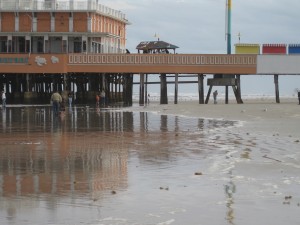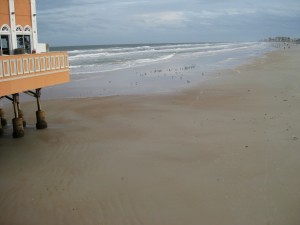January 2nd, 2009 by Frank LaBanca, Ed.D.
 My family and I have been enjoying a respite in Daytona Beach and I have had a chance to enjoy some downtime. This downtime is so important to the creative mind, because it offers opportunities to develop thoughts without the pressures and confines of the traditional work schedule. I’ve often walked up and down the beach, with family, spouse, children, and alone just to admire nature’s presence. Of course, if you look west, there is a plethora of high-rise buildings and extensive development. But, walking on the sand and facing east, leaves an unadulterated view of the beauty and grandeur of Mother Nature in one of my favorite forms: the ocean.
My family and I have been enjoying a respite in Daytona Beach and I have had a chance to enjoy some downtime. This downtime is so important to the creative mind, because it offers opportunities to develop thoughts without the pressures and confines of the traditional work schedule. I’ve often walked up and down the beach, with family, spouse, children, and alone just to admire nature’s presence. Of course, if you look west, there is a plethora of high-rise buildings and extensive development. But, walking on the sand and facing east, leaves an unadulterated view of the beauty and grandeur of Mother Nature in one of my favorite forms: the ocean.
Daytona Beach has a fairly active surf and the sand on the beach is peculiarly clean, without the too often found litter, flotsam, and jetsam that unfortunately crowd the pathway of a nature walker. I am surprised how flat the beach is and how few shells are mingled within the sand. Nonetheless, the intense, crashing, powerful sounds of the waves are soothing and relaxing.
 As you look south, down the beach, there is only one obstruction in the water, and that is the Main Street pier. The peer stretches perpendicular to the beach, about the length of a football field. There is a building in the middle of it, and is uncrowded with only a few fishermen seeking a catch. I had walked past the pier, both over and under, several times, but on a recent trip, I noticed something on the sand. The pier has created an unnatural obstruction in the sand, and has caused it to pool around the piers. This situation often occurs when human interference, particularly in the form of jetties or groins are installed to stop beach erosion. However, beaches move, whether we like it or not, and attempts to stabilize them nearly always make things worse.
As you look south, down the beach, there is only one obstruction in the water, and that is the Main Street pier. The peer stretches perpendicular to the beach, about the length of a football field. There is a building in the middle of it, and is uncrowded with only a few fishermen seeking a catch. I had walked past the pier, both over and under, several times, but on a recent trip, I noticed something on the sand. The pier has created an unnatural obstruction in the sand, and has caused it to pool around the piers. This situation often occurs when human interference, particularly in the form of jetties or groins are installed to stop beach erosion. However, beaches move, whether we like it or not, and attempts to stabilize them nearly always make things worse.
I had originally learned about beach movement in a graduate coastal ecology class I took with George McManus , a fabulous marine biology professor at UConn-Avery Point. A video “The Beaches are Moving,” with Dr. Orrin Pikey discusses the phenomenon. After seeing the video, and follow up reading that I’ve done, I am constantly amazed that human-imposed techniques are used to interfere with nature’s might. If you’ve ever seen “Deadliest Catch,” you know that the ocean is a powerful force and a human-built structure really has no chance against the awesome power of the sea.
So, as a scientist, I thought it was cool that I had the chance to subtly observe a human-nature interaction, but as an educator, it has me thinking about other things . . .
Many professional development opportunities ask teachers to think about their students from a “Multiple Intelligences” perspective. The list of intelligences, currently at eight is:
-
Bodily-Kinesthetic
-
Interpersonal
-
Verbal-linguistic
-
Logical-Mathematical
-
Naturalistic
-
Intrapersonal
-
Visual-Spatial
-
Musical
Some characterize the multiple intelligences concept as a theory, but there has been little-to-no empirical evidence to support that claim. Ironically (or maybe not so ironically) the conceiver, Howard Gardner, does not want is multiple intelligences concept used as learning theory.
Some might consider my observation about the pier to be a naturalistic intelligence. Now for a brief sidebar . . . In the past, in the Estuary Watch Program, I’ve collaborated with two professors, Dr. Lisa Kaplan from Quinnipiac University, and Dr. Joe Crivello from UConn. Joe had an amazing ability to observe nature, and know just where to dip his net in a marsh to come up with an amazing catch of grass shrimp. Lisa, a more contemplative scientist, would often comment how Joe just seemed to have amazing hands – whatever he touched always seemed to work for him whether in the field or in his laboratory.
The more I think about this “naturalistic” intelligence, the more I think, that the naturalist, really just has an excellent visual-spatial acuity. After all, naturalism, really is just a specific interest, and may not be an intelligence unto itself. Every time I interact with someone who has clear naturalistic interest and aptitude, always seems to have excellent spatial perspective.
As educators and researchers, we should be critical of that which does not have clear empirical evidence. The way we educate children should be based on clear, evidence-based practice.